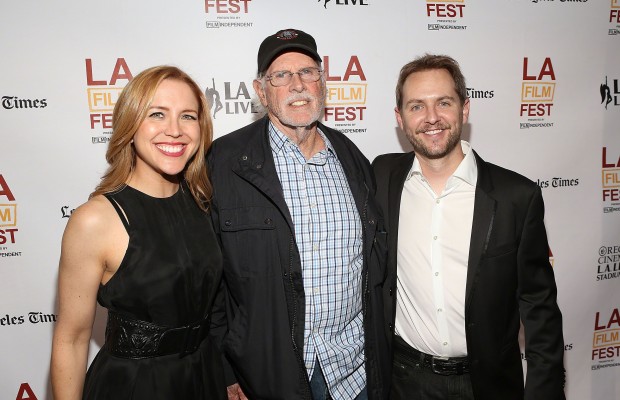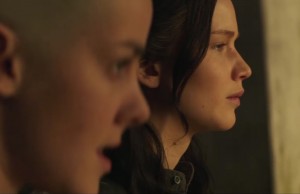“Cut Bank” Director Matt Shakman Talks Working With John Malkovch, Billy Bob Thorton, And Bruce Dern
By Rosemary Vega on June 19, 2014@rosevega- Tweet
-
- Pin It

Producer Laura Rister, actor Bruce Dern and director Matt Shakman
With TV credits for shows like Mad Men, New Girl, Fargo, and It’s Always Sunny in Philadelphia already under his belt, Matt Shakman made his directorial film debut with “Cut Bank,” which includes an all star cast made up of Liam Hemsworth, Billy Bob Thorton, John Malkovich, Oliver Platt, and Bruce Dern.
In the film Hemsworth plays Dwayne McLaren, a young guy who wants nothing more than to leave his small hometown of Cut Bank, Montana, a town whose only notable feature is being the “coldest spot in the nation.” Dwayne works as a mechanic for his girlfriend Cassandra’s (Teresa Palmer) father (Billy Bob Thornton). While filming Cassandra at his favorite spot, Dwayne accidentally captures the murder of town mailman Georgie Wits (Dern). So it seems, anyway.
With a reward of $100.000 to anyone who can offer evidence for the murder, Dwayne quickly hands over the seemingly convincing tape to Sheriff Vogel (John Malkovick), who is completely unprepared for the violent crime. But the two, and postal inspector Joe Barrett (Oliver Platt), don’t expect Derby Milton (Michael Stuhlbarg), a creepy taxidermist, to emerge. All Derby wants is a lunch box that was a part of Georgie’s undelivered mail. He would do anything to get his lunch box.
After the screenplay appeared on the Black List, Shakman quickly jumped at the chance to direct. We spoke with Shakman right after the film’s premiere at the LA Film Festival to talk his transition from directing TV to film, working with the brilliant actors that were meticulously cast, dealing with severe heat while filming, and much more.
HTS: I know you’ve directed television, but this was your first film. How was it like transitioning from TV to film? Were there any challenges with that?
Shakman: Yes. I mean after years of directing television, I thought I would be well prepared for something that moved quickly. But, in independent film it turns out that you actually have less time than you have in television because you’re working in mostly practical locations, you’ve got a crew that’s just coming together just for that one film as opposed to a group that’s working together all year. They’re creating that world from the ground up, so you have to work efficiently. So I’m really glad I had that television background to be able to move quickly.
HTS: What was your favorite scene to shoot in the film?
Shakman: I think probably the scenes where John Malkovich goes into Derby’s house and moves into his basement. It was a pleasure to create that world with our production designer Laura Fox,- who is a genius- and to build a really specific world for Derby, Michael Stuhlbarg’s character, that felt like you hadn’t seen it before. Somewhere that could be seen early in the film and not have as much of a dark tone appearance to it, and then later have it change as we go into Malkovich’s point of view as he’s moving into this person’s lair, who he now realizes is a danger person. I think I liked working on that stuff the most.
HTS: I heard it was really hot when you guys were filming, and there was one particular scene that was really challenging. Tell me about that challenging scene and going through that day.
Shakman: We happened to be in the city of Edmonton on the hottest day on record. It was well over 120 degrees and we were in a metal trailer, which was the location- the junk lot trailer office. We were tenting it, so we were covering it all in black fabric so it would look like it was nighttime. There we were in the middle of the day, in a metal trailer, surrounded by black fabric and it was 120 degrees outside. So, it was probably a lot hotter, even than that, inside. And poor Bruce Dern and poor Liam Hemsworth were in there, acting as hard as they could while dealing with this incredibly miserable condition. It was also too small to have an air conditioner in there. When we finally got air conditioning in there, it was too loud during the takes, so it ended up doing almost nothing. That was the toughest, physically. As for the rest of it, we were pretty lucky. We didn’t have too much weather interference, rain or anything, that got in the way, just the heat.
HTS: Was anyone fainting or anything?
Shakman: It certainly looked like they might! Including me, but we managed to make it. If you look carefully in the film, you can see that Bruce is pretty red, and so is Liam. There’s a little bit of sweat in their shirts. But other than that, you can’t really tell. I think it worked out okay. Now, I just went and did Fargo, the mini series, up in Calgary, which is right near Edmonton. Now I’ve been on both extremes of 120 degrees, all the way down to minus 30. So it’s quiet a sweep. That province has both sides of the thermometer going.
HTS: You’ve really had to bare the elements! So tell me about how you got involved with the film. How were you approached?
Shakman: The film made it to something called the Black List here in Hollywood, which is a list of best un-produced screenplays that are voted on by agents and executives and producers. That’s where it first started getting attention. It was sent to me shortly after it got on the Black List by a producer who was working on the film and who I had worked with on another project a few years ago. It also arrived from my agent and my manager on the same day. So I got this script sent to me three times on the same day. I think it was meant to be. I read it, and I loved it. I thought the characters were brilliant. The world was original and unique. It was a mas- up of thriller, drama and black comedy in a way that I hadn’t seen. I thought it would be a wonderful challenge.
HTS: I read that you started off in theater. How did that influence the way you directed the film, if it did at all?
Shakman: I think it definitely does. I do direct a lot of theater. I love working with actors. I love developing plays from the ground up- I do only new plays. I think it’s a similar process to work on a film. You’re assembling a group of actors, and many of them, I reached out specifically because I loved their theater work. Malkovich, Michael Stuhlbarg, Oliver Platt- these guys are all fantastic stage actors. It’s a similar way of working. It’s a way that I understand that I think they work like as well. I bring that part of it- the working with actors, the development of scripts, from theater into film. Obviously there’s the technical and visual aspects that are different and those I’ve luckily had television as a background to work on as well. It’s a nice marriage of what theater offers in terms of storytelling and working with actors and what the camera can do in filmmaking.
HTS: You mentioned working with really great actors, which they all were wonderful. What was casting like? Did you have certain actors in mind? How did you get that cast together?
Shaman: Very, very slowly, very methodically over several years. We were very careful about who we were offering roles to and only going after people that we really loved and wanted to be in the film. Luckily John Malkovich signed up; He was the first one on board several years ago. He stuck with us for a couple years as we assembled the rest of the actors and the financing.If he hadn’t stuck with us the movie never would have happened. So I’m really in his debt. He responded to the material, to the character, and then we had a great meeting and he signed up. I think his big thumbs up and sign of approval really helped with the other actors we were going after.
HTS: You described the film as a modern day western. I’ve noticed directors really like westerns, but audiences aren’t always so keen to them. How do you think audiences will respond, or how have they been responding, to the film?
Shakman: I think the response has been very good. And yeah, I do love westerns. Directors do love westerns. But I think this one is a thriller, a drama. The elements that it has, that it shares with a western, is that sort of sense of loneliness and isolation. The city of Cut Bank is out in this really isolated part of Montana. It really does feel a little bit like the old west in that there’s a really large Native American reservation with the Black Foot Indian population living separate from the town Cut Bank, which is predominantly white. It feels a little like a John Ford film already in the way that it’s sort of isolating those two populations. But it isn’t going to be guys riding horses and all that sort of stuff. It is a contemporary movie taking place in the present. It is about something that we can all relate to, which is feeling trapped in a small town wanting to get out and follow our dreams.
HTS: If you were to insert yourself into the film, which character do you think you would be and why?
Shakman: That’s a funny question! They’re all so unique, so specific, that I would be scared to be inserted into any of them. They are all their own people, completely. I would probably be more Sheriff Vogel, more than anybody else, which is John Malcovich’s part. I think I understand that character being overwhelmed by the city and not quite sure how to handle this first bit of murder and violence in his town. I can understand that dilemma. I’m afraid of spiders, so I think Sheriff Vogel and I have a lot in common.
HTS: Derby’s character goes on a killing spree. Did you imagine that as being a product of circumstance or did you always imagine him having that killer in him?
Shakman: Very good question. He is the most reasonable person in the film from where I stand. All he wants is his lunchbox, and if only these people would give it to him, everything would be fine. Instead, they antagonize him, and torture him, and poke him. So, what’s he going to do? Even at the end of the movie, he almost walksaway leaving Liam Hemsworth’s character and Teresa Palmer’s character fine, until he realizes that he’s also been betrayed by them. He’s reasonable in that he has a pretty simple request and just wants his lunchbox. But Derby is much like Sheriff Vogel and much like Billy Bob Thorton’s character. He’s obsessed with keeping things the same and preserving the past and preserving a more innocent time. They’re all afraid of modernity. They’re all afraid of what the outside world can do… He’s not too different from Sheriff Vogel and Big Stan and their fear of change. I think he slowly became the person capable of violence that he shows in the movie because he removed himself further and further from the world and the world became more and more persistent that it would come after him, and that’s where the violence in the film really bubbles over.
HTS: Now that you’ve gotten your first film out of the way, do you have any plans for a another movie yet? Or do you know what type of movie you’d want to direct next?
Shakman: I have no specific plans for what would be next movie wise. There are a couple projects we’re trying to get off the ground. I’d like to do something different. Much like in theater where directors get a chance to go from a brand new play to Shakespeare, I like the chance to work in different genres and tones. Same way in television, I love to be able to go from Mad Men to It’s Always Sunny in Philadelphia to Fargo, to be able to mix it up. The next thing I would love to do wouldn’t be a modern western or a thriller per se, but it would be something different.
HTS: Any specific people you’d like to work with?
Shakman: More of the same kinds of actors that I’ve been working with. In Cut Bank, we had actors like John Malkovich, like Billy Bob Thorton, like Bruce Dern, people who can do anything. I think that if we wanted to do Cut Bank again, we could switch everybody’s part and it would be fine. It would be great. It would be like having a company of great actors. Being around people like that is what it’s all about for me, so I’m thrilled for that chance.
You may also like...
Copyright © 2013 Hot Topix Theme. Theme by MVP Themes, powered by Wordpress.



